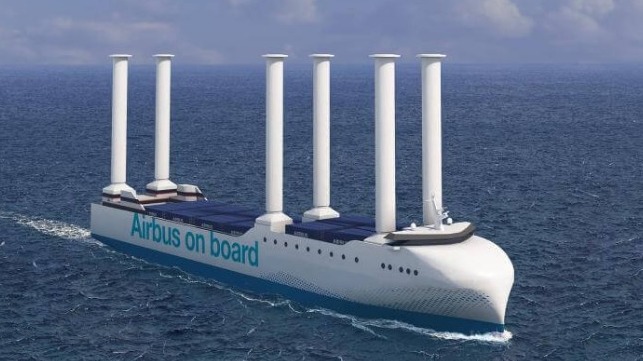Airbus and Louis Dreyfus Will Build Low Emission Dual-Fuel and Wind Ro-Ros

European aviation company Airbus working with French shipping company Louis Dreyfus Armateurs plans to replace its existing fleet of ro-ro cargo ships with three new fuel-efficient vessels to transport aircraft components across the Atlantic. They highlight that the effort which includes the use of rotors and dual-fuel e-methanol engines is part of an overall effort to lower the carbon emissions from their operations.
They are reported to be in negotiations with shipyards for an order to build three ro-ro cargo vessels that would incorporate the fuel saving and lower emissions technologies while also expanding Airbus’ shipping capacity. Registered in France, each of the vessels would have six Flettner rotors and two dual-fuel engines. The engines will run on marine diesel and e-methanol. They plan for the vessels to begin to enter service in 2026 and gradually phase out the company’s existing fleet.
Over time, they also expect to increase the percentage of e-methanol used by the ships. Currently, on ro-ro, the Ville de Bordeaux emits 41,000 tons of CO2 on an Atlantic crossing while the other vessel, the City of Hamburg, emits 27,000 tonnes. By 2030, the new vessels will emit 11,000 tonnes and as they increase the use of e-methanol it will fall to 5,000 each by 2040 for the three new ships.
Airbus’ goal is to reduce emissions from its Atlantic fleet by 50 percent by 2030 compared to a 2023 baseline. The new fleet is projected to reduce average annual transatlantic CO2 emissions from 68,000 to 33,000 tones by 2030. It is part of Airbus’ commitment to reduce its overall industrial emissions by 63 percent by the end of the decade compared to 2015 as a baseline.
The aviation company has already begun several steps aimed at reducing emissions. The ro-ro Ville de Bordeaux began testing a kite-like technology in 2022 and recently plans were announced to add suction wing sails to the vessel. Airbus has also introduced the use of sustainable aviation fuel and its road operations use biogas when possible.
Today, Airbus has three charted vessels operating on two routes carrying containers as well as subassemblies ranging from wings, fuselage, horizontal and vertical tail components, and engine pylons. On the Mediterranean, the Ciudad de Cadiz (3,500 dwt built in 2009) makes stops at Airbus and supplier production facilities in Tunis, Naples, Porto, and Saint-Nazaire. The Ville de Bordeaux (5,200 dwt built in 2004) and the City of Hamburg (3,500 dwt built in 2008) cross the Atlantic. Components are moved from Saint-Nazaire, France to the Airbus final assembly line in Mobile, Alabama.
As the fleet is gradually renewed, the Ciudad de Cadiz will be retired from service. When the first of the new Atlantic vessels enters service in 2026, the City of Hamburg will transfer to the Mediterranean. When the second new vessel is delivered, the Ville de Bordeaux will move to the Mediterranean to replace the City of Hamburg.
Airbus reports the renewal of the shipping fleet is also part of an effort to increase production of its A320 class of planes to 75 aircraft per month by 2026. The new vessels will have the capacity to transport around 70 40-foot containers and six aircraft subassembly sets. The Ville de Bordeaux currently transports four subassembly sets while the City of Hamburg only has space for three. The added capacity Airbus reports could also be used for other divisions or its partners.
